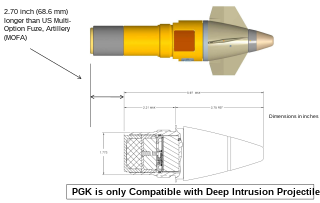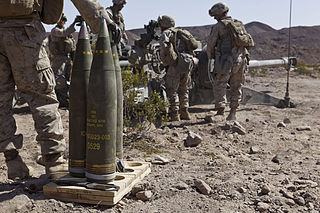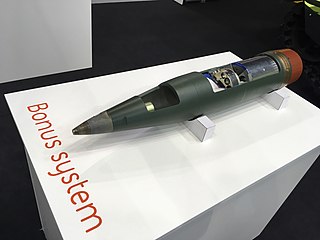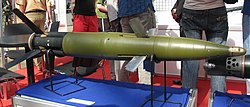
The M198 is a medium-sized, towed 155 mm artillery piece, developed for service with the United States Army and Marine Corps. It was commissioned to be a replacement for the World War II-era M114 155 mm howitzer. It was designed and prototyped at the Rock Island Arsenal in 1969 with firing tests beginning in 1970 and went into full production there in 1978. It entered service in 1979 and since then 1,600 units have been produced.

Nuclear artillery is a subset of limited-yield tactical nuclear weapons, in particular those weapons that are launched from the ground at battlefield targets. Nuclear artillery is commonly associated with shells delivered by a cannon, but in a technical sense short-range artillery rockets or tactical ballistic missiles are also included.
Pansarsprängvinggranat m/94STRIX is a Swedish endphase-guided projectile fired from a 120 mm mortar currently manufactured by Saab Bofors Dynamics.

The M777 howitzer is a British towed 155 mm artillery piece in the howitzer class. It is used by the ground forces of Australia, Canada, Colombia, India, Saudi Arabia, Ukraine, and the United States. It was first used in combat during the War in Afghanistan.

A dual-purpose improved conventional munition (DPICM) is an artillery or surface-to-surface missile warhead designed to burst into submunitions at an optimum altitude and distance from the desired target for dense area coverage. The submunitions use both shaped charges for the anti-armor role, and fragmentation for the antipersonnel role, hence the nomenclature "dual-purpose". Some submunitions may be designed for delayed reaction or mobility denial (mines). The air-to-surface variety of this kind of munition is better known as a cluster bomb. They are banned by more than 100 countries under the Convention on Cluster Munitions.

The M712 Copperhead is a 155 mm caliber cannon-launched guided projectile. It is a fin-stabilized, terminally laser guided, explosive shell intended to engage hard point targets such as tanks, self-propelled howitzers or other high-value targets. It may be fired from different artillery pieces, such as the M114, M109, M198, M777 and CAESAR howitzers. The projectile has a minimum range of 3 km (1.9 mi) and a maximum range of 16 km (9.9 mi).

The M982 Excalibur is a 155 mm extended-range guided artillery shell developed in a collaborative effort between the U.S. Army Research Laboratory (ARL) and the United States Army Armament Research, Development and Engineering Center (ARDEC). The Excalibur was developed and/or manufactured by prime contractor Raytheon Missiles & Defense, BAE Systems AB and other subs and primes in multiple capacities such as Camber Corporation and Huntington Ingalls Industries. It is a GPS and inertial-guided munition capable of being used in close support situations within 75–150 meters (250–490 ft) of friendly troops or in situations where targets might be prohibitively close to civilians to attack with conventional unguided artillery fire. In 2015, the United States planned to procure 7,474 rounds with a FY 2015 total program cost of US$1.9341 billion at an average cost of US$258,777 per unit. By 2016, unit costs were reduced to US$68,000 per round. Versions that add laser-guidance capability and are designed to be fired from naval guns began testing in 2015. By October 2018, over 1,400 rounds had been fired in combat.
The XM1111 Mid-Range Munition (MRM) is a 120 mm precision guided munition developed for the Rheinmetall Rh-120 120mm gun used by several Western tanks. It was also intended to fulfill a requirement for Future Combat Systems (canceled) for a long-range, beyond line of sight (BLOS) tank munition.

The XM395 Precision Guided Mortar Munition (PGMM) is a 120 mm guided mortar round developed by Alliant Techsystems.

The Extended Range Guided Munition was a precision guided rocket-assisted 5-inch (127 mm) shell (projectile) development by Raytheon for the U.S. Navy. The program was cancelled in March 2008 after twelve years of development and over 600 million dollars in funding. The developmental round was designated EX 171.
The Ballistic Trajectory Extended Range Munition (BTERM) was a failed program to develop a precision guided rocket-assisted 127 mm (5-inch) artillery shell for the U.S. Navy. The program was originally named the Autonomous Naval Support Round (ANSR) and was developed by Alliant Techsystems.

The M1156 Precision Guidance Kit (PGK), formerly XM1156, is a U.S. Army-designed precision guidance system to turn existing 155 mm artillery shells into smart weapons. The prime contractor was Alliant Techsystems – later merging with Orbital Sciences Corporation to form Orbital ATK, in turn being taken over by Northrop Grumman and renamed Northrop Grumman Innovation Systems – and the industry team includes Interstate Electronics Corporation. By April 2018, more than 25,000 PGKs had been produced.

The PLZ-45 or Type 88 is a 155 mm self-propelled howitzer developed by Norinco. It is based on Norinco's Type 89 (PLL-01) 155 mm/45-calibre towed gun-howitzer.

The 2A65 "Msta-B" is a Soviet towed 152.4 mm howitzer. The "B" in the designation is an abbreviation for Buksiruyemaya, which means towed. This weapon has been fielded in Soviet forces since at least 1987 and as of 2022 is currently in service with Russian front and army level artillery units, as well as the militaries of six other countries, most of them former Soviet republics.

A precision-guided munition (PGM), also called a smart weapon, smart munition, or smart bomb, is a guided munition intended to hit a specific target, to minimize collateral damage and increase lethality against intended targets. During the Persian Gulf War guided munitions accounted for only 9% of weapons fired, but accounted for 75% of all successful hits. Despite guided weapons generally being used on more difficult targets, they were still 35 times more likely to destroy their targets per weapon dropped.
The SMArt 155 is a German 155 mm artillery round designed for a long-range, indirect fire top-attack role against armoured vehicles. The projectile was developed in 1989 by Diehl BGT Defence in Überlingen, Germany, with Rheinmetall and started full-rate production for the German Army in 1998. It consists of a 47-kilogram (104 lb) heavy artillery projectile containing two autonomous, sensor-fused, "fire-and-forget" submunitions. Due to the submunitions, it has been considered by some to be a cluster munition. As of 2008, representatives of the German defense ministry have referred to it as not being classified as submunition weapons, which were prohibited by the 2008 Convention on Cluster Munitions.
Cannon-launched guided projectiles (CLGP) are precision-guided munitions launched by howitzers, mortars, tank guns, and naval guns. Those projectile main propulsion system is the initial kinetic shoot, directed as much as possible toward the target. A secondary GPS or geocoordinates-based system then corrects the trajectory to increase target accuracy and fall closer to the target. This system relies on electronic guidance and pre-programmed coordinates, submitted to the round before its launch.

The M795 155 mm projectile is the US Army and US Marine Corps' standard 155 mm High Explosive (HE) projectile for howitzers. It is a bursting round with fragmentation and blast effects.

The M549 is a high-explosive rocket-assisted (HERA) 155 mm howitzer round developed for use by the US military in order to add additional range to standard howitzers, with a maximum range 30.1 km (18.7 mi) from a M198 howitzer. The projectile has two distinctive pre-assembled components—the high-explosive (HE) warhead and the rocket motor, making it a form of rocket-assisted projectile. The warhead is fabricated from high-fragmentation steel for increased effectiveness in terms of damage caused to target and contains a bulk-filled explosive.

The BONUS or ACED is a 155 mm artillery cluster round co-developed and manufactured by Bofors of Sweden and Nexter of France. It was designed to fulfill a long range, indirect fire, top attack requirement against armoured fighting vehicles.
















